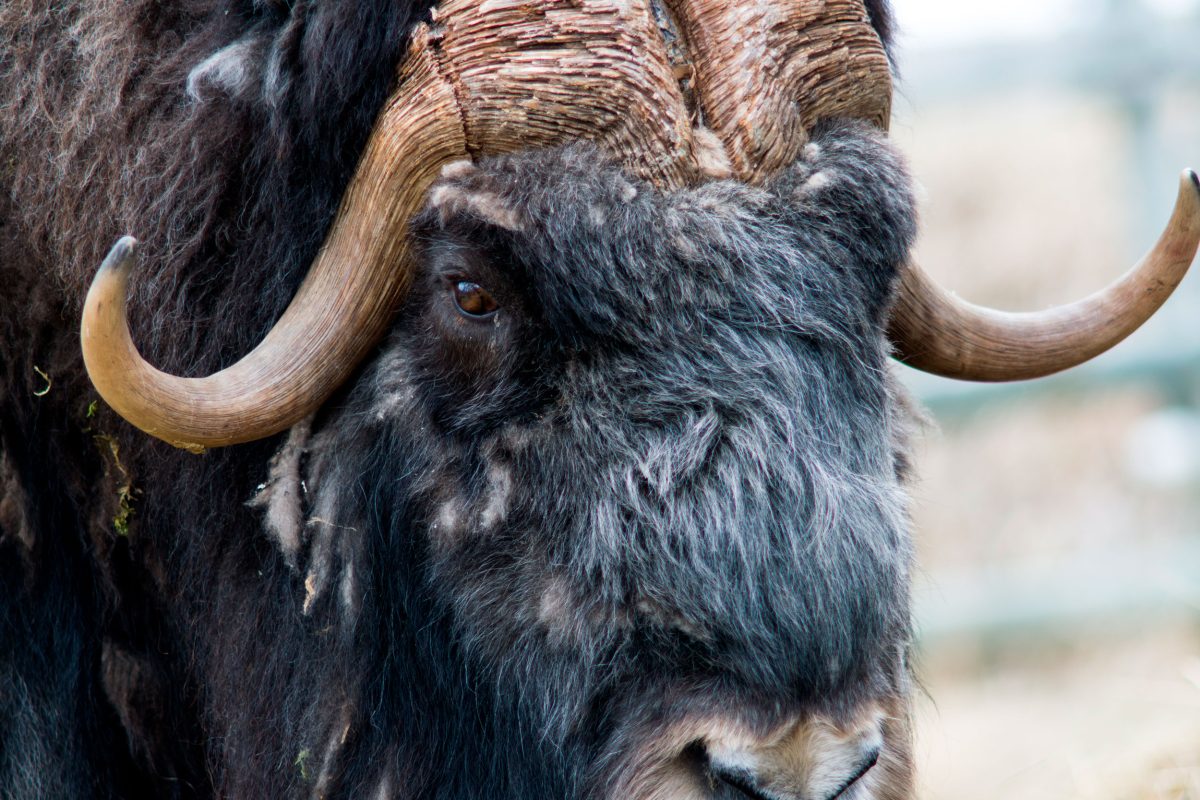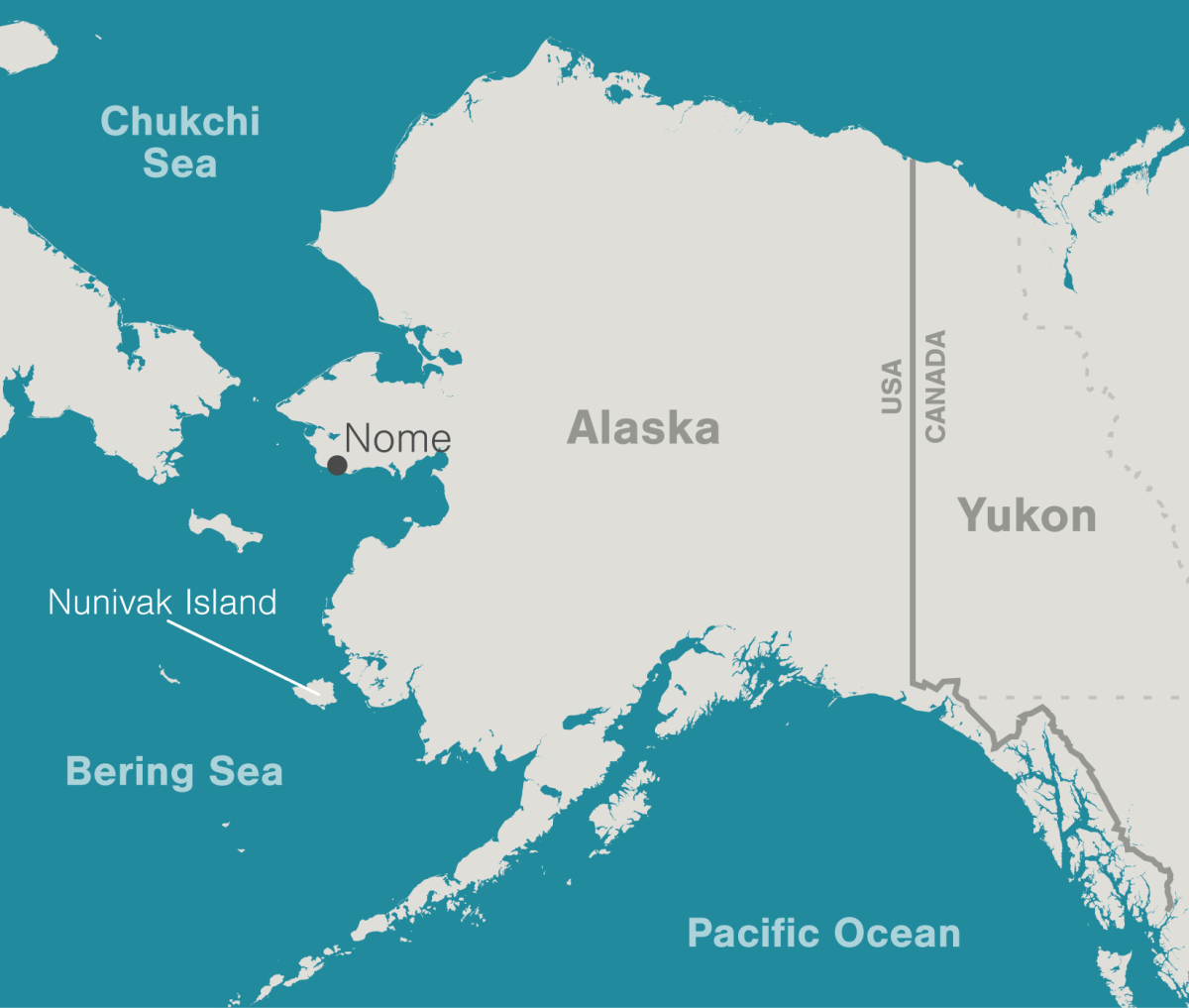In Nome, Where the Muskoxen Roam … Controversially
In Alaska, residents are negotiating a contentious relationship with muskoxen, which were introduced to the area decades ago without local consent.
Article body copy
This article was originally published in High Country News, a magazine about the western United States’ environment and communities, and is republished here with permission. Read more stories like this at hcn.org.
By the afternoon of December 13, 2022, idyllic winter conditions had finally arrived in Nome, Alaska. Famous for hosting the finish of the Iditarod sled dog race, this remote town is closer to Russia than it is to Anchorage, Alaska; here, vast tundra landscapes meet the sea ice that forms over the Bering Strait. A series of dreaded rain-on-snow events earlier in the month had made winter travel miserable. But now, a fresh white blanket covered the rolling hills, reflecting the pinks and blues of a clear subarctic sky. Snow machines were whining, and the local mushers were looking forward to another season of exercising their sled dogs. One of them, Curtis Worland, took a break from work to visit his kennel on the outskirts of Nome.
Worland was a court services officer for the Alaska State Troopers, a job that involved prisoner transport and court security. At the kennel, though, he had other obligations. Keeping a dog lot anywhere requires a constant loop of chores: feeding dogs, running dogs, scooping up dog poop. But keeping one in Nome comes with additional responsibilities: monitoring threats from muskoxen, stubborn, shaggy animals with formidable horns and a record of attacking dogs. During his decade as a musher, Worland, 36, had seen Nome’s muskoxen problems increase. He shared the dog lot with his wife and their friends, and about once a week, when muskoxen got too close, he took on the task of keeping the animals away. On December 13, he was on a snow machine, trying to scare off a herd that had come within half a kilometer of the lot. No one else witnessed what happened, but one of the animals charged him. Worland received a fatal laceration to his femoral artery, and by the time emergency responders arrived, he had bled out.
The portrait that the Alaska State Troopers released in their announcement of his death shows a serious-looking man in a uniform and a fur hat. But in the slide show during his memorial service at the local recreation center, Worland is often wearing an open-mouthed smile or tearing it up on a dance floor. Sudden deaths are painful in any small town—Nome has around 3,700 people—and Worland was a well-liked member of the community, remembered for his adventurous spirit and love of hunting and the outdoors.
Worland was also Nome’s first muskox-related human fatality.
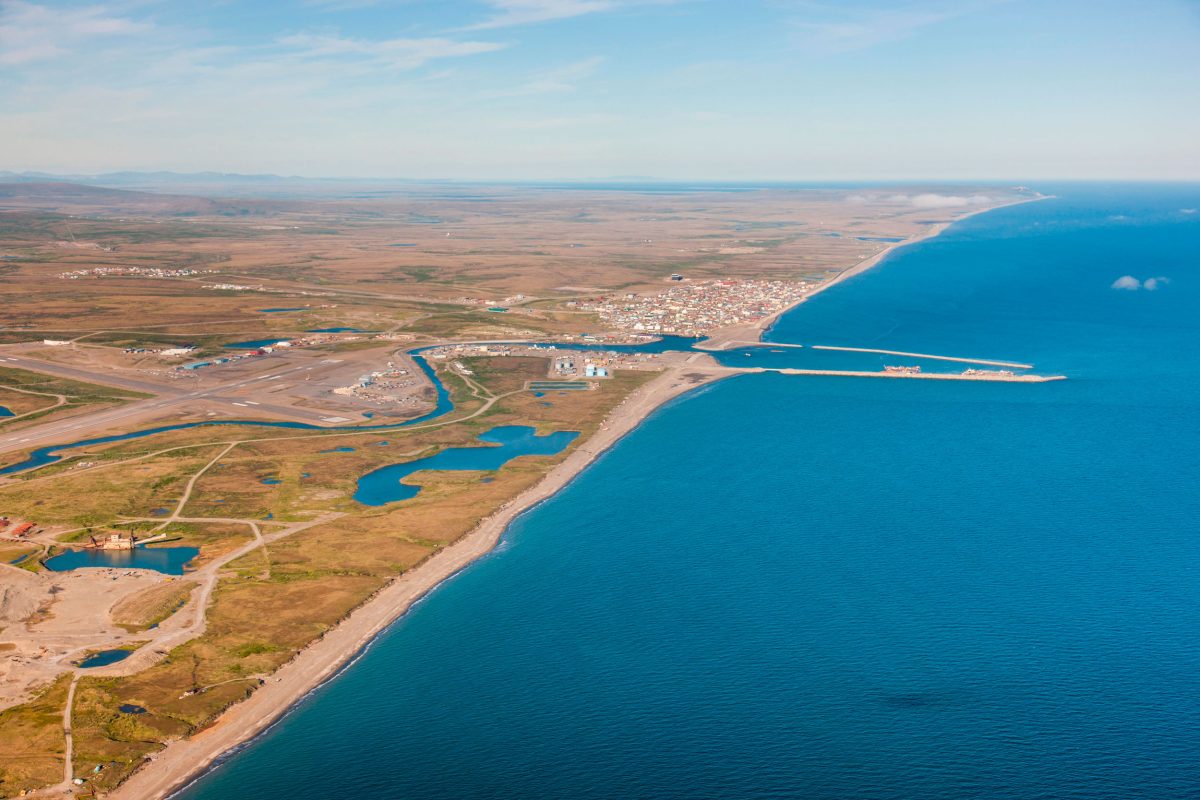
Nome, Alaska, has a population of roughly 3,700 people—and more than 2,000 muskoxen. Photo by Design Pics Inc/Alamy Stock Photo
On the Monday afternoon following his death, nearly 20 residents crowded into a small conference room at the University of Alaska Fairbanks campus in Nome. The Northern Norton Sound Fish and Game Advisory Committee was meeting for its biannual discussion regarding policy recommendations for state decision-makers. It’s the kind of meeting that rarely excites the public, but this one turned into an impromptu hearing on the town’s muskoxen problem. A dozen locals either called in or showed up in person, with several testifying to frequent run-ins and fears of more encounters. Mushers said that dogs were getting gored and it was getting harder to protect their kennels—but they were worried that any deterrence efforts would lead to accusations of wildlife harassment.
The Nome Nugget, the local newspaper where I work as a reporter, published Nome resident Miranda Musich’s statement to the panel: “What happened to Curtis was the final straw for me,” she said. “We understand that muskoxen are here and that they will not go away, but we feel that they have been mismanaged and that we don’t have the right to protect ourselves and our property without risk of us being prosecuted for defending ourselves.” After the tragedy, Musich helped compile testimonies from other residents. To many in Nome, Worland’s death wasn’t a freak accident; it was an indictment of the region’s muskoxen management and the century of decisions that brought them here.
One Iñupiaq word for muskox is umiŋmak, a term that refers to the animal’s beard-like coat. The word’s existence speaks to the Iñupiat’s long relationship with muskoxen, which once roamed the Arctic. The decline of muskoxen is often attributed to climatic changes after the last ice age, along with predation and hunting. Around Nome, few, if any, Indigenous stories about the animals survive.
MaryJane Litchard, an Iñupiaq artist and healer who grew up in Alaska’s Lost River, Teller, Anchorage, and Nome, tells me that she never heard stories about muskoxen growing up—“not even [from] my granduncle when he told me true ancient stories.” Elders told her that people sometimes saw creatures that were extinct, such as mastodons. As a teenager in the 1960s, Litchard heard someone describe seeing a blue-colored muskox and asking an elder if they’d seen a ghost.
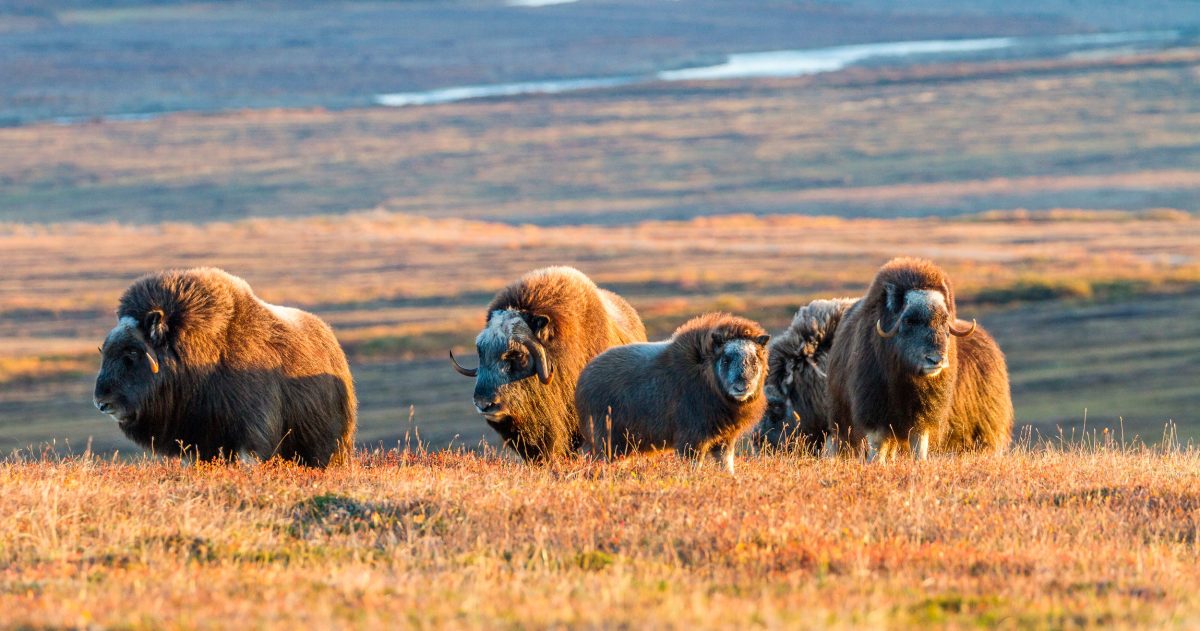
Muskoxen were quickly becoming ghosts on the Alaskan landscape by the time of European settlement. Photo by Jacob Loyacano/Shutterstock
Records from early European settlers suggest that by the time they arrived, the animals were already rare in the region, mostly restricted to far northeastern Greenland and Northern Canada. “Epidemic disease associated with exploration and colonization—1837 smallpox, 1900 measles, 1917 influenza—caused massive culture disruption,” says Jim Magdanz, who worked for the Alaska Department of Fish and Game’s Division of Subsistence from 1981 to 2012 and has searched for stories about muskoxen. “In some villages, only children survived. Indigenous histories of muskox use either died in the epidemics or were rarely recorded when oral histories were written by explorers and settlers.”
The average visitor to Nome today would never guess that muskoxen were ever ghosts on the landscape. The animals adorn guidebooks and artwork at gift shops and draw wildlife viewers and photographers. With their bulky coats, sloping shoulders, short legs, and upturned horns, it’s not hard to picture them roaming alongside saber-toothed cats, wooly mammoths, and other big-bodied beasts of the Pleistocene. But all the muskoxen around Nome today have ancestors that saw the inside of a train station in New Jersey. Their reintroduction to Alaska was the result of a decades-long campaign by early 20th-century settlers and promoters, one that followed a template used many times over before and since: it was a plan for developing the Arctic, drawn up without the consent of Indigenous people.
Even before the gold rush arrived in Nome, settlers were tinkering with the region’s large fauna. On the treeless tundra landscapes, missionaries imagined fields of grazing animals and a whole new economy that would feed—and help assimilate—Alaska Natives. Later, settlers saw an opportunity to make their own fortunes. The introduction of domestic reindeer is perhaps the best-known attempt to turn this colonial fantasy into reality. But others championed muskoxen as an Arctic agricultural alternative; among them was Vilhjalmur Stefansson, a Canadian anthropologist who relentlessly promoted the observations he made during a series of Arctic expeditions in the early 1900s. On one expedition, he interviewed Indigenous people and settlers, who told him of a hunting party that had killed a small herd of muskoxen around 1858. “Since then,” he wrote, “no one near Point Barrow is known to have killed muskox or seen them,” marking their presumed extirpation from the region. After encountering the animals and hunting them in the Canadian Arctic, he endorsed the species as a source for the US meat market.
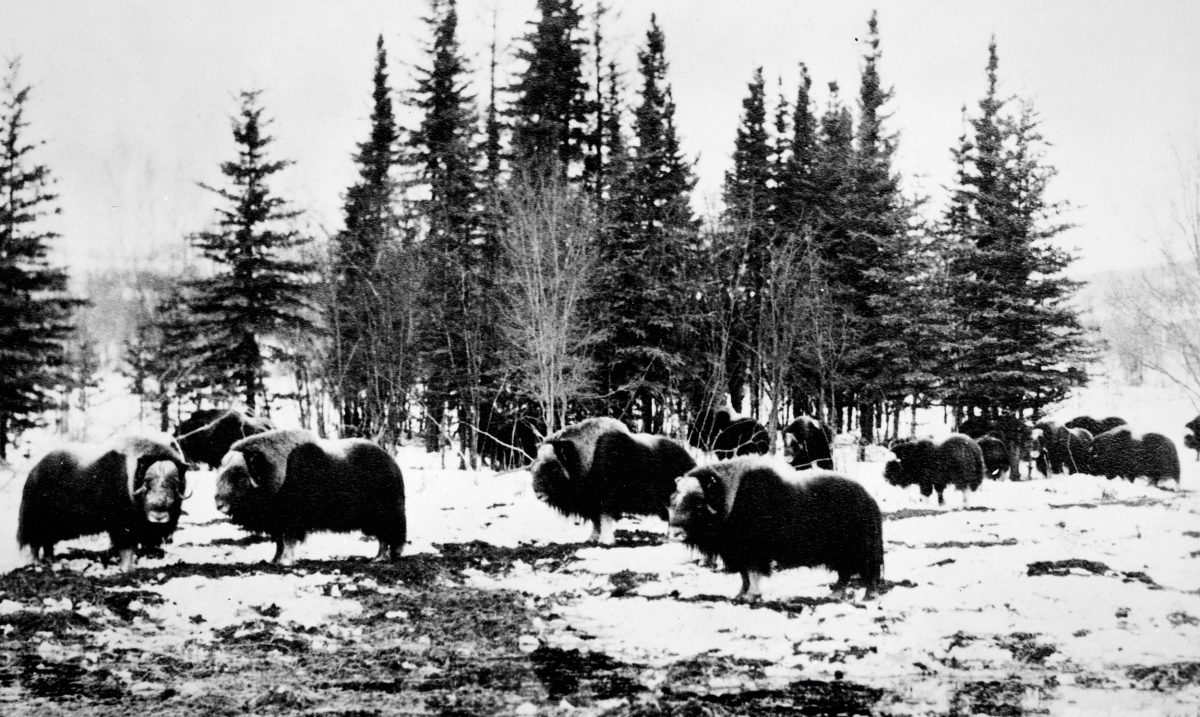
Muskoxen from Greenland were transplanted to a destination near Fairbanks, Alaska, in late 1930, but the habitat proved unsuitable. Photo courtesy of University of Fairbanks Archives, Fannie Quigley Collection, Alaska and Polar Regions Collections, Elmer E. Rasmuson Library UAF-1980-46-85.
Though Stefansson sometimes challenged outsiders’ notions of a “lifeless” and “desolate” Arctic, some of the colonial representatives who supported him did not. Stefansson apparently made a case for repopulating the Arctic with muskoxen to Thomas Riggs, governor of the Territory of Alaska from 1918 to 1921. In his 1918 report to US Congress, Riggs thanked Stefansson and wrote that muskoxen seemed “designed to make a productive country” out of “barrens now serving no purpose”—revealing the governor’s view of the Indigenous homelands of northern Alaska.
Irving McKenny Reed, who grew up in Nome’s gold-mining camps and was an early member of the Alaska Game Commission, was also a major force behind the reintroduction. He met Stefansson in Nome, collected stories about muskoxen across Alaska, and, in 1922, traveled to New York City, where he spoke with New York Zoological Park director William Hornaday about the zoo’s experience with the species. Reed also promoted the scheme to the US Congress, which allocated US $40,000 to the United States Biological Survey in 1930 to acquire and domesticate muskoxen for Alaska.
It would be another 40 years before the animals set hoof on Alaska’s Seward Peninsula. In the summer of 1930, Norwegian sailors captured dozens of young muskoxen in eastern Greenland, and 34 of them arrived by steamship in New York Harbor that September. After a month-long quarantine, they began an epic journey, by train and steamship and train again, from New Jersey to their near-final destination outside Fairbanks, Alaska. Eventually, the herd’s habitat, in a clearing in a boreal forest, was deemed unsuitable—due in part to the cost of the fencing required to keep muskoxen in and black bears out—and the Biological Survey’s plans to domesticate them were abandoned. Thirty-one muskoxen were moved to Nunivak Island, off the coast of southwestern Alaska, in 1936. The population grew, and a program for transplanting them to the mainland was launched by state and federal partners in 1967.
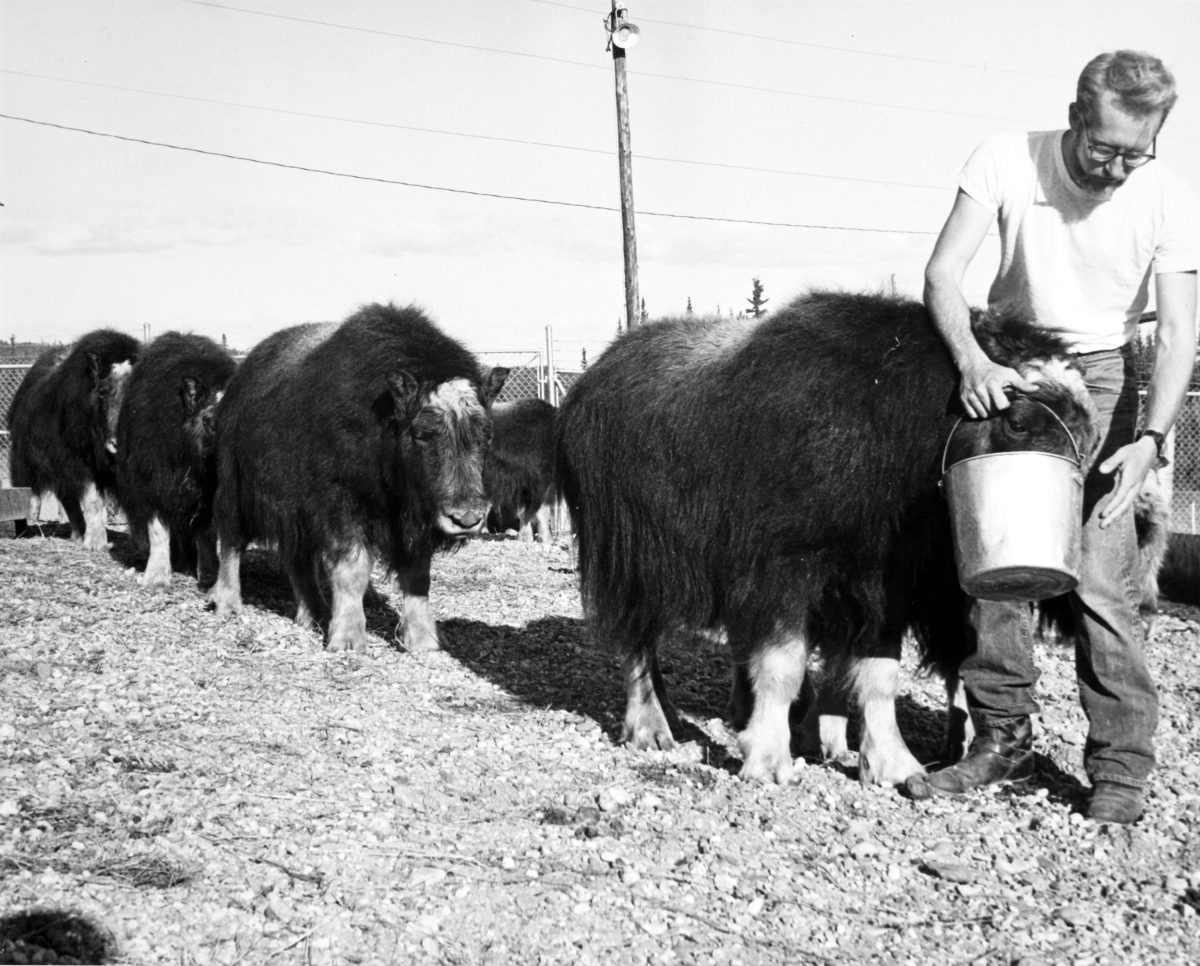
A worker feeds muskoxen at an Alaskan farm, circa 1964–1974. Photo courtesy of University of Fairbanks Archives, Historical Photograph Collection, Alaska and Polar Regions Collections, Elmer E. Rasmuson Library UAF-1983-209-53
In 1970, 36 muskoxen were transferred to the Feather River watershed, about 40 kilometers northwest of Nome. They didn’t stay put. Within a year, they had traveled farther north and were living around the village of Brevig Mission. State and federal officials added another 35 animals in 1981 to supplement the fledgling population. After that, it took off, expanding across the Seward Peninsula. The population hit a peak in 2010 with a survey count of 2,903 but then declined until 2015 when it stabilized. The most recent survey of the peninsula’s musk oxen, in 2021, counted 2,071.
Nome has a tribally owned hospital, direct Alaska Airlines flights to Anchorage, and a gravel road system that makes it possible to access the varied landscapes of the Seward Peninsula. But no roads connect it with Alaska’s cities: mass-produced food and supplies must be flown or barged in, and the cost of living is high. In 2022, gas prices reached more than $1.85 per liter; a gallon of milk can cost over $2.00. The price of remoteness is even higher in the villages scattered around the Bering Strait. Nome serves as the hub community for 15 of those villages, which are majority Alaska Native and range in size from 80 to 800 residents. Inequities rooted in colonialism mean that several still lack basic services like water and sewer systems. Residents’ ability to put local fish, meat, and berries in their freezers is crucial not only to their food security but also to the survival of centuries-old traditional ways of life.
“To limit describing our way of life to ‘food security’ would be like viewing the bread and wine of Communion for the poverty-stricken from purely a nutritional standpoint,” Melanie Bahnke (St. Lawrence Island Yupik), president and CEO of Kawerak, the region’s tribal nonprofit consortium, said in testimony to the Senate Committee on Indian Affairs in 2013. “Our [subsistent] way of life provides us with sustenance, a sense of well-being and purpose, a feeling of belonging, the understanding that we are part of something much bigger than us as individuals, pride in carrying on a way of life passed down from generation to generation, joy in sharing, and also serves as the core of our identity as an Alaska Native civilization.” She also described the barriers that impede the survival of these traditions: in order to harvest resources such as salmon, moose, and, now, muskoxen, Alaska Natives must navigate a thicket of multijurisdictional policies, all while contending with the colonial legacy of exclusion from resource governance. Bahnke tells me that she stands by those words today.
Before muskoxen were introduced northwest of Nome in 1970, state and federal officials typically didn’t consult, let alone inform, nearby residents. And the main purpose of the introduction—to provide meat for residents—wouldn’t be fulfilled for another two decades because the population had to multiply before hunting could be authorized. As a result, the imported muskoxen had to coexist with human communities that had not consented to their presence, saw no immediate benefit from it, and had little or no recent experience with the animals.
Friction between the new neighbors was, perhaps, inevitable. Kate Persons was the area biologist for the Alaska Department of Fish and Game’s Nome office between 1997 and 2007—when muskoxen had reached the periphery of Nome but had not yet become regulars in town. Most of the complaints about the animals that Persons fielded came from the villages. “People just really didn’t like them, and that was a pretty prevalent feeling throughout the villages at that time,” she recalls. Muskoxen often move in herds, which can range in size from a handful of animals up to 75. And while many animals flee from humans, muskoxen tend to hold their ground, forming a tight line or circle. That makes them easy to hunt but hard to scare off if they are, for example, trampling traditional gathering grounds for berries or tundra greens.
When muskoxen hunting finally became a possibility in the Seward Peninsula in the mid-1990s, its management was convoluted and controversial. Many of Alaska’s resources are governed by a dual-management system, meaning that multiple federal and state authorities may share responsibility for wildlife. And their policies don’t always align. For instance, the federal Alaska National Interest Lands Conservation Act passed in 1980 gives priority to rural residents, who are majority Indigenous, in their use of fish and wildlife for subsistence purposes. In 1989, the state Supreme Court deemed such preferences illegal on state lands, and some in the hunting community continue to push back against the priority access held by rural Alaskans under federal law. Although some 60 percent of Alaska is federal land, most of the area immediately around Nome falls under state jurisdiction.
Local subsistence users weren’t the only group interested in hunting muskoxen. When sport hunting for the animals began on Nunivak Island in the 1970s and on the North Slope in the 1980s, locals in these regions had to compete for state hunting permits with sport hunters from Anchorage or Fairbanks. The Seward Peninsula is easier to access from these cities, and in the 1990s, many peninsula residents feared they would face even fiercer competition for permits. After the area’s muskoxen population dropped by nearly 25 percent between 2010 and 2012, the state put more restrictions on hunting. Now, all applicants for state permits to hunt muskoxen around Nome must document an economic need for the animal’s meat. During the 2022–23 season in the Seward Peninsula, 29 muskoxen were harvested in the state hunt, and five were taken on federal land.
Beyond the politics of hunting them, the management of muskoxen around Nome is complicated by how the animals move—and don’t move. Starting around 2007, for reasons researchers and managers can’t fully explain, muskoxen seemed to become especially keen on Nome. They began spending more time in town, and reports of conflicts accumulated: Muskoxen broke through fences, mounted doorsteps, obstructed traffic, and trampled gravesites. They gored beloved pets. Before the Nome Airport installed a perimeter fence in 2019, herds sometimes interfered with flights by blocking the runways.
The state doesn’t consistently track human-muskoxen conflicts, but The Nome Nugget tries to document any incidents. In fact, less than 24 hours before Worland’s death, I spoke to Shawn Pomrenke, a Nome resident and a star of the reality TV show Bering Sea Gold, whose 10-year-old dog Kona had just survived her second gruesome brush with a muskox. Pomrenke said he thought more action to reduce conflicts would only occur after someone got hurt. The following day, his words felt eerily prescient.
Why are muskoxen so attracted to Nome? There are a few theories. The presence of humans might shield them from predators like brown bears. Town might offer better dining options, too: muskoxen usually start wandering into Nome in larger numbers in May, when plant life is starting to re-emerge. Claudia Ihl, a biologist who has been studying muskoxen for more than two decades and is an associate professor at the University of Alaska Fairbanks campus in Nome, suspects they’re drawn to disturbed sites in and around town, where thick stands of nutrient-packed young horsetails, willows, sedges, and grasses sprout early in the season. “If they can access sites like this, where they’re ahead by even just a week or so, and get this nutrient peak as early as possible, it just gives them a huge advantage,” Ihl says. In fact, she thinks the muskoxen help tend these urban pastures. “By coming back repeatedly, cropping these, and leaving some fertilizer, they’re basically maintaining their own lawns,” Ihl says.
Muskoxen munch fall foliage in Alaska. The animals rely on grasses, sedges, forbs, and woody plants to sustain themselves. Video by Pronghorn Productions/Shutterstock
A further complication for managers—and residents—is that more than one subpopulation of muskoxen likes to hang out in and around Nome. Stefansson believed that the animals rarely traveled more than eight kilometers a month. But muskoxen defied those sedentary expectations soon after their reintroduction to Alaska, and in recent decades, state and federal biologists have tracked muskoxen crisscrossing the Seward Peninsula in stunning walkabouts.
Managers and residents have been building an unofficial body of research in another area: muskox deterrence strategies. Over the last 15 years, state managers, airport officials, dog-lot owners, and others in Nome have tried to scare off muskoxen with beanbag guns, fire hoses, squirt guns, helicopters, bear urine, chainsaws, and crumpled water bottles—no one knows why, but some muskoxen hate the sound of a plastic water bottle being crumpled. So far, it seems that heavy-duty game fencing is the only reliable way to keep humans and animals safe from muskoxen. “If you don’t want wild animals in your yard, fencing is the answer,” says Sara Henslee, the Alaska Department of Fish and Game’s current area wildlife biologist for Nome. Henslee says local discussions always seem to revolve around what the agency is doing to push muskoxen out of town. “Really, the conversation, I think, should be how do we protect our property permanently, which is through the use of fencing.” Some community members resent the suggestion that fencing is the only solution. Fencing doesn’t eliminate the prospect of unwanted encounters on mushing and hiking trails near town, though backcountry travel has always carried risks. And while muskoxen are less of a nuisance in town in winter, Nome’s notorious snow drifts can grow tall enough to render even the strongest fence useless.
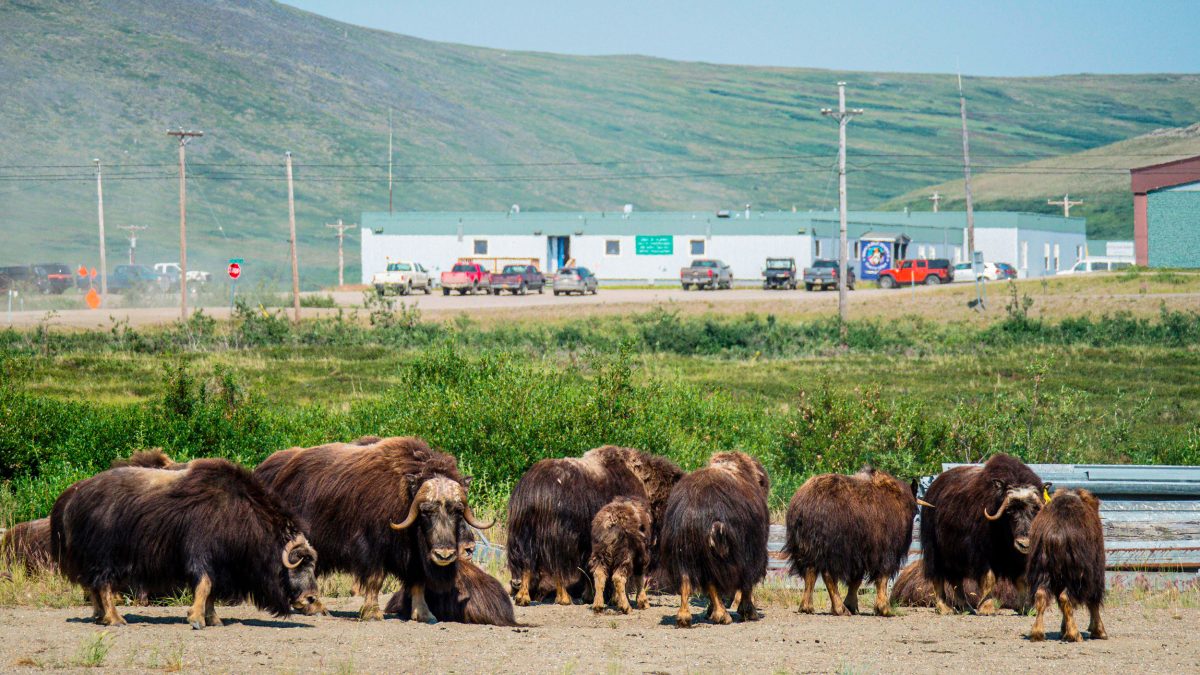
Wildlife managers and researchers aren’t sure why, but in 2007, some muskoxen began to favor spending time in Nome. Photo by Michael S. Nolan/Alamy Stock Photo
The Alaska Department of Fish and Game (ADFG) and other managers have improved their consultation policies since muskoxen were introduced to the Seward Peninsula, but those changes can’t solve the current problem—or erase the original insult. “I think that’s where all of this contempt of the animal comes from, this feeling that we didn’t even want them here,” Henslee says. “That’s the number-one thing I hear. I can have discussions all day long with folks about what they need to do, and they just come back and say, ‘Well, we never wanted them here in the first place.’”
After Worland’s death, ADFG faced pressure to go beyond its recommendation of better fencing. The Northern Norton Sound Fish and Game Advisory Committee, whose December 2022 meeting was unusually crowded, met again in March 2023. This time, the only attendees were the committee members, Henslee, myself, and a hunting guide who called in to talk about bears. Henslee announced that ADFG would raise its annual muskoxen hunting quota in the Nome area from nine animals to 30 and that the hunt would include female muskoxen for the first time in a decade. The intent is in part to make Nome less appealing to muskoxen, though a few seasons will likely be needed to test the strategy’s effectiveness.
Some committee members feared the measure went too far and could unintentionally cause the population to collapse. Other residents thought the changes didn’t go far enough. Kamey Kapp-Worland, Curtis’s widow, said the lack of more proactive deterrence measures by ADFG dishonored her husband’s memory. Just a few weeks earlier, Iditarod musher Bridgett Watkins had carried Worland’s ashes to Nome in her sled. She crossed under the burled arch at the finish line, accompanied by a procession of emergency response and law enforcement vehicles.
At the heart of the controversy lies a bigger question. “Would the muskox situation in Nome be different if the people of the Seward Peninsula had managed them all along, instead of the Alaska Board of Game and the Federal Subsistence Board?” wonders Magdanz. “For me, that’s kind of the big question that faces all of Alaska. … Would Seward Peninsula people have made different decisions? And would this musher be alive today if local people had more authority in managing these resources?”
After Worland’s death, Melanie Bahnke of Kawerak wrote an open letter to policymakers and game managers, asking for further action to protect the community. “Our Tribal Leaders and elders traditionally were the ones who made decisions about the take of fish and game in our region and what is reasonable and allowable and what measures to take to protect our people,” she wrote. “I guarantee this situation would not be as out of hand as it is now if that authority had not been replaced by the current management regimes that are woefully inadequate considering the fish crashes and the current threat to humans posed by muskox.”
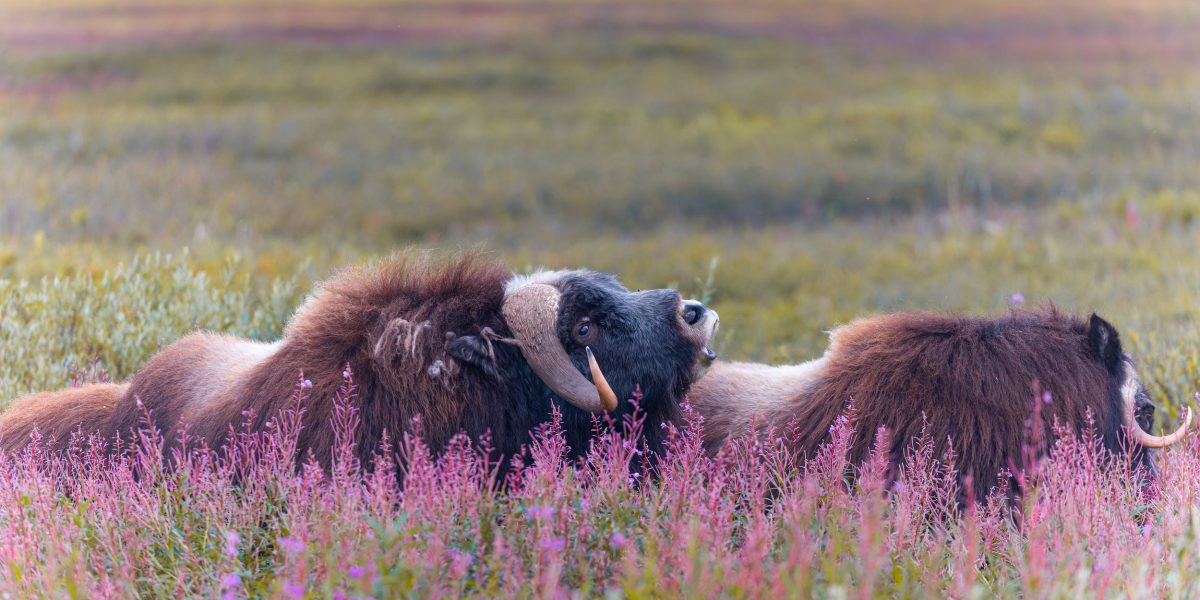
Though public opinion on muskoxen in Nome is divided, no one is seriously campaigning to get rid of the animals. Photo by Mark Lindberg/Shutterstock
Still, locals who regularly manage to get hunting permits are finally seeing the benefits of muskoxen. They’re good eating, and in winter, they have unusually lightweight but superwarm underwool, called qiviut, that can be spun into yarn and is far more valuable than cashmere. Roy Ashenfelter, an Iñupiaq hunter from White Mountain, Alaska, who spent decades working on various subsistence advisory boards and who now chairs the board of the Bering Straits Native Corporation, has seen public opinion about muskoxen become more divided. “Now you’ve got a situation where that dynamic is not to one side—it could be argued equally on both sides,” Ashenfelter says.
There’s no time machine to reverse the situation, and no one is seriously campaigning to eliminate muskoxen from the Seward Peninsula. Bahnke and her colleagues at Kawerak are strong advocates of more comanagement and costewardship of the region’s resources, but right now they are focused on the salmon crisis, which affects far more households. “The most urgent situation, and thus where most of our energy has been spent, is with our fish declines,” she tells me.
As Nome continues to negotiate its relationship with muskoxen, the animals might serve as a cautionary case study for state and federal agencies. When I dug through the old arguments for their introduction, trying to understand the roots of current frustrations and resentments, I was struck by a sense of familiarity. The excitement about muskoxen from Stefansson and his ilk was fueled by outsiders’ dreams of untapped Arctic potential: the boom that’s just around the corner, the fix that’s bound to guarantee prosperity to a region remote from national power centers. In 2024, the details of the schemes look different—an expanded port to accommodate more cruise ships and cargo barges and military vessels, a graphite mine to accommodate the national drive for American-sourced critical minerals—but their shape remains familiar. Often these plans come from outsiders who imagine something new and grand here, whether it’s a field full of productive ungulates or a navy destroyer in port. And, now as then, they offer vague promises of local benefits, accompanied by serious questions about the control of resources—and the specter of tragic consequences.
This story is part of High Country News’s Conservation Beyond Boundaries project, which is supported by the BAND Foundation.

